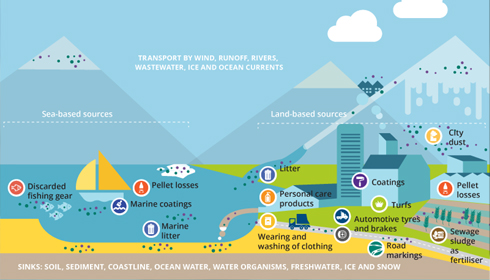
Heriot-Watt University Unveils Groundbreaking Fiber Fragmentation Scale to Combat Microplastic Pollution
In a major development, Heriot-Watt University academics have developed the world's first visual grading system to address the fashion industry's considerable contribution to microplastic contamination. This ground-breaking experiment, led by Dr. Lisa Macintyre, an associate professor at the School of Textiles and Design, uses a five-point fiber fragmentation scale to evaluate the volume of fibers shed from clothing materials during use and washing.
The global microplastic issue is serious, with over 14 million metric tonnes projected to be on the ocean floor. Synthetic textiles, such as polyester and nylon, are significant contributors to shedding microplastic fibers during regular use and laundry. These threads, which range in size from a fraction of a centimeter to many centimeters, enter ecosystems, endangering marine life, animals, and human health.
Dr. Macintyre noted, "Fibre pieces are found everywhere, from icebergs to the deepest ocean to human lungs and food. The fashion and textiles industry is one of the leading contributors of secondary microplastics, and our project intends to assist makers and consumers in making better decisions."
The newly designed scale, which rates materials from "1" (highest shedding) to "5" (lowest shedding), is faster and less expensive than previous systems, including those employed by the International Organisation for Standardisation (ISO). The procedure entails testing textile samples in a 'rotawash' machine to simulate a laundry cycle. The effluent is subsequently filtered, and the fibers are visually graded on a scale.
Dr. Macintyre stated, "Visual scales are currently used in the fashion industry to quantify material bobbling or color fading; but until today, there was no tool for measuring fiber shedding." This scale not only makes material selection easier for manufacturers, but it also allows them to accurately explain fiber shedding levels to customers."
Sophia Murden, a PhD scholar who helped build the scale, added, "Our system is straightforward and cost-effective. It is much more accurate for determining low fragmentation levels than standard weighing methods."
Brands like Helly Hansen and Lochcarron in Scotland have previously shown support for the fiber fragmentation scale. If widely adopted, the fiber fragmentation scale could be displayed on garment labels in a similar manner to how food packaging displays nutritional information.
Dr. Macintyre emphasized the broader ramifications, saying, "Currently, there is no agreed-upon 'acceptable fragmentation' rate for clothing, but we hope that this research will lead to industry standards and, potentially, legislation against high-shedding materials."
The fiber fragmentation scale is a critical step toward minimizing microplastic pollution and developing sustainable fashion practices since it empowers manufacturers to choose low-shedding textiles and assists consumers in making educated selections.